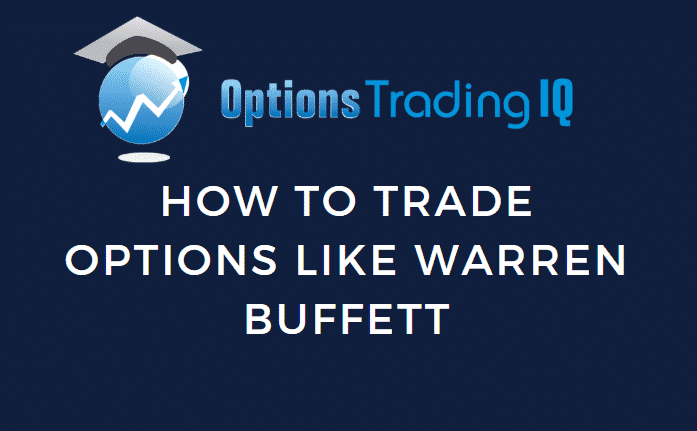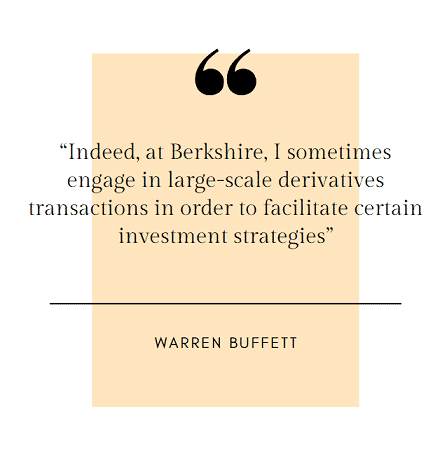

Contents
- What Kind of Options Does Warren Buffet Trade?
- How Does Warren Buffett Trade Options?
- How Does Warren Buffet Profit from Naked Put Options?
- But Wait, There’s More to the Story
- Can You Trade Options Like Warren Buffet?
It may sound surprising to you that Warren Buffet, the acclaimed long-term passive investor who once said that derivatives were “financial weapons of mass destruction”, is actually very engaged in trading options as part of the regular business conducted by the massive conglomerate, Berkshire Hathaway.
Well, it’s not like Buffet’s investing philosophy or approach has changed, rather, he found a way to trade options with very little risk, and high rewards. Not a combination that you usually see in traditional investment operations.
Here are some key insights on how to trade options like Warren Buffet.
What Kind of Options Does Warren Buffet Trade?
Mainly, naked put options. A put option gives the holder the right, not the obligation, to sell the underlying asset at a pre-defined price, known as the strike price. Someone who buys a put option usually intends to hedge the risk that the price of the underlying security falls.
By buying this put option, the investor can lock-in the price at which he will sell the security when the option matures. If the market price is lower than the strike price, then the investor can exercise the put option and lock-in a higher price. Instead, if the market price is higher, the investor can decide not to exercise the put option, and sell the security directly in the open market.
On the opposite side of that operation, you’ll find Warren Buffet. He is the one writing the put option, and he’s doing so in a very unique way.

How Does Warren Buffett Trade Options?
There are basically two ways to write an option:
- Covered Option – In this case, you own the underlying asset and you are permitted to right a call or put option on it. To write a covered call option, you need to hold a long position on the underlying asset. On the other hand, to write a covered put option, you have to short-sell the underlying asset.
- Naked Option – This type of options doesn’t require that you hold the asset. You just promise the buyer you’ll be able to settle the put or call option once the maturity date is reached
A naked put option, then, is a contract that entitles the holder to sell the underlying asset at the pre-established price, at a certain point in time. The party who wrote the option is entitled to a “premium”, and that is exactly what Warren Buffet is looking to earn.
How Does Warren Buffet Profit from Naked Put Options?
Berkshire Hathaway owns several insurance companies that, as part of their regular operations, invest money in the stock market to generate income from the money it collects from its premiums upfront, also known as “float”.
This float provides interest-free investment funds that the insurance company can employ to generate additional income. Now, the insurance company, as a way to generate even additional income, could write covered call options on these financial instruments, but that’s a risky bet.
What Warren Buffet does, instead, is to write naked put options to generate some side income from collecting the premiums generated by the options, by using the creditworthiness of its large conglomerate and insurance business, that holds billions of dollars in sound financial and fixed assets.
The insurance company doesn’t have to short-sell the underlying asset of the puts, as brokers are willing to accept the naked puts from Berkshire’s insurance companies, with the underlying assumption that they will be able to cover for them in the event that the holder exercises the put option.
If the market price of the underlying security is lower than the strike price at the moment the put option matures, the holder will exercise it and Berkshire will have to pay for the difference. Now, here’s what’s genius about this strategy. Berkshire issues naked put options on stocks they currently hold, and these are stocks that Warren Buffet actually invests in.
This means that Warren is expecting these stocks to keep increasing in value over time, and the naked put options have a maturity date of 15 to 20 years. Therefore, he’s basically doing what he always does, which is to believe in a stock’s long-term performance, and he’s profiting from this by using the naked puts.
But Wait, There’s More to the Story
The money collected as a premium from writing the naked put option can be invested by Mr. Buffet for more than 15 to 20 years, which is the moment when the naked puts will mature. Considering Mr. Buffet’s incredible investment performance over time, he’s probably sure he can invest this money in a profitable way, and, therefore, in the event that these put options are exercised, he would have already produced millions of dollars in dividends and capital gains from the premium initially collected.
Can You Trade Options Like Warren Buffet?
Not in the exact same way, but you can definitely do something similar by using covered options instead.
In order to sell covered put options, you would have to short-sell a certain stock that you expect to increase in price over time. This operation will generate a premium that you have to invest in a profitable way to generate additional money.
The maturity date for the covered put option should be far enough to reduce the risk of short-term volatility that can be smoothed by letting the market run its course for a while. This can be achieved by selling Long-term Equity Anticipation Securities (LEAPS).
The results of this strategy can be calculated as follows:
Return = Premium Collected from Selling Covered Put + Investment Income from Investing the funds obtained through short-selling the stock and the collected premium + Net result from shorting the stock – Cost of settling the covered put option
The risks associated with this strategy are:
- If the strike price is higher than the market price at the maturity date of the put option, the put can generate unlimited loses.
- If the stock’s price drops, the short-selling operation of the underlying asset can also generate unlimited losses.
- If the premium collected and the money from the short sale is not invested wisely, it could produce loses as well.
Trade safe!
Disclaimer: The information above is for educational purposes only and should not be treated as investment advice. The strategy presented would not be suitable for investors who are not familiar with exchange traded options. Any readers interested in this strategy should do their own research and seek advice from a licensed financial adviser.











The article lists the risks as ” If the stock’s price drops, the short-selling operation of the underlying asset can also generate unlimited losses”
Why is it so? A short-seller profits when the price drops. He loses when the price increases because he has to cover at a higher cost.
Can you pls. clarify? Preferably with an example?
Thanks, I’ve re-worded that. Selling puts, can generate large losses if the stock drops. It’s a bullish strategy.